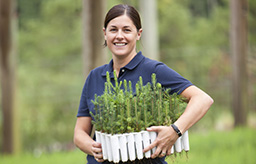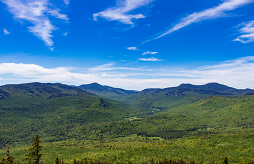Listening to Forest Song Birds
J.D. Irving, Limited (JDI) has partnered with Natural Resources Canada, Carleton University, and Environment and Climate Change Canada on a 5- year songbird habitat research project on JDI land in Northern New Brunswick.
“Understanding and modelling specific habitat use and needs of birds at the local and landscape scale is an effective way to analyze the influence of forest management on songbird diversity and abundance,” said Greg Adams, JDI Woodlands Research and Development Manager. “This approach is especially useful in the forestry context because it can allow projections into the future under specific management regimes as well as under different climate change scenarios.”
Researchers are collecting songbird data with auto-acoustic recording devices. During the breeding season in May and June of 2016, 323 sites were monitored across 17 different forest types and age classes. The recordings are being analyzed by bird experts or in some cases by sound recognition software to determine songbirds present at specific GPS locations. Researchers also have access to JDI’s enhanced, high resolution mapping of the entire forest study area for a range of forest structure metrics generated through LiDAR (Light Detection and Ranging) technology. The songbird data is then used along with the forest structure metrics at the location as well as in the surrounding forest area to build habitat models for individual species. Model results can then be projected across the entire landscape.
“This is a great opportunity for us as scientists to use this forest as case study to see how future forest changes may impact the ecology.” said Joe Bennett, Assistant Professor at the Institute of Environmental Science and Department of Biology at Carleton University
“If you are doing things right, if you are maintaining long-term sustainability of the forest then you are going to be providing habitat for forest songbirds; so this study will be able to provide lots of information about forest integrity and sustainability,” said Lisa Venier, Research Scientist, Natural Resources Canada. “It’s very exciting working in a place like this where so much spatial and environmental data has already been collected, in fact there’s more data available here than almost any other research forest in Canada I think so this opportunity is unprecedented.”
Over 500 hours of expert listening to the recordings is being conducted with first year results to be completed in early 2017. Monitoring and analysis of breeding data will continue for several years and form the basis for ongoing monitoring, especially in light of climate change.
.jpg)
Photo Caption: Forest Songbird Research Team during tour of JDI’s Black Brook forest ( left to right) (left to right) Joe Bennett, Assistant Professor at the Institute of Environmental Science and Department of Biology at Carleton University; Scott Wilson, Research Scientist, Environment and Climate Change Canada ; Lisa Venier, Research Scientist, Natural Resources Canada; and Shawna Masson, Masters Student, Carleton University.
Questions about our Healthy Forest Approach? Read the FAQ.
(1).png?n=7605)
.jpg)













.jpg)





.jpg?n=6166)
.jpg)





